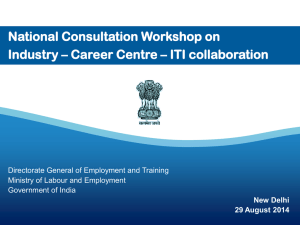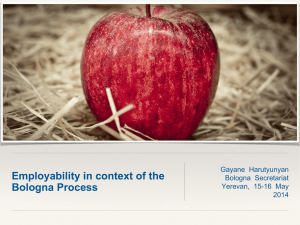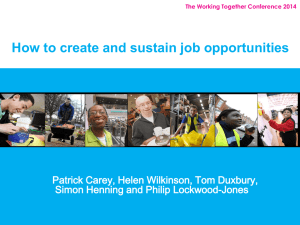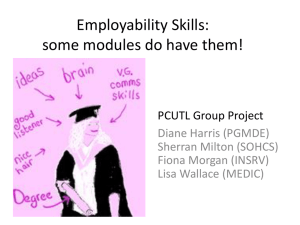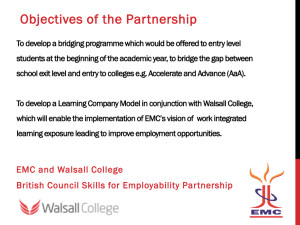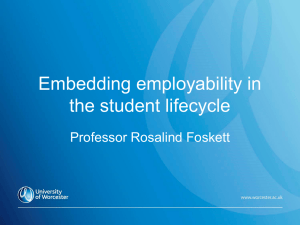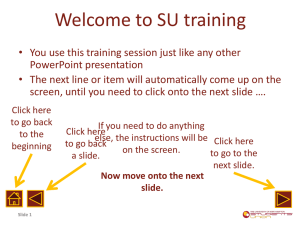Initial Assessment - Department of Economic Opportunity
advertisement
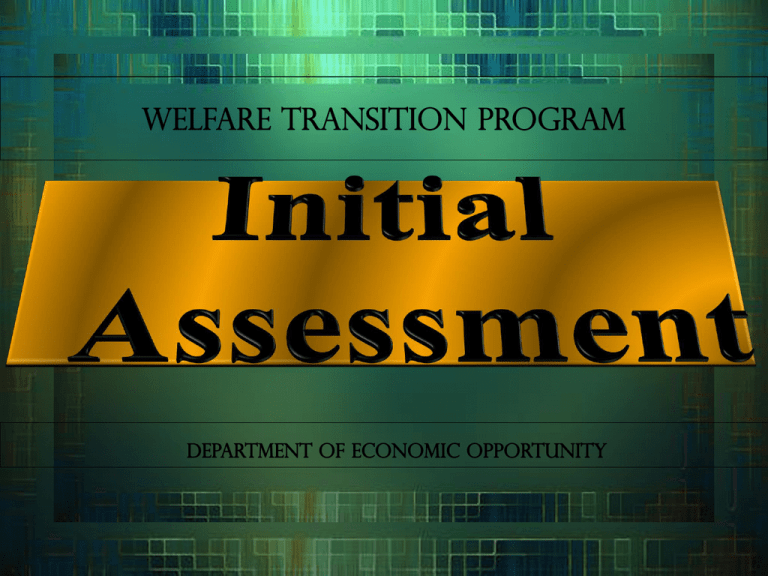
Initial Assessment – an organized procedure used to evaluate an individual’s skills, work history and employability Individual Responsibility Plan – a plan that outlines a participant’s strategies to pursue and accomplish their goals Mandatory Participant – an individual that is required to participate in the Welfare Transition program Program Engagement – program activities that participants are engaged in to help move them from welfare to work Skills – the abilities obtained by an individual as a result of a job or position Work History – chronicle of jobs held by the participant Employability – an individual’s readiness for hiring or engagement Barriers – obstacles that hinder or limit the ability of the participant to work or engage in work activity CFR 261.11 (a) The State must make an initial assessment of the skills, prior work experience, and employability of each recipient who is at least age 18 or who has not completed high school (or equivalent) and is not attending secondary school. (b) The State must make any required assessments within 30 days of the date an individual becomes eligible for assistance. What’s Being Assessed? Skills Work History Employability Needs Barriers Work Ethic Personality Type When? Federal Regulation States The Initial Assessment must occur within 30 days of a customer becoming eligible for cash assistance. Initial Assessment May be 30 days prior to becoming mandatory No longer than 30 days after the receipt of the alert Should begin prior to educational program referrals Ensures program alignment with customer’s career interest Exposes barriers that may hinder customer success within program Should begin prior to work engagement Ensures work activity alignment with customer’s career interest Exposes barriers that may hinder customer success at worksite Should begin prior to employer referrals Ensures customer’s skills match those requested by the employer To assess the customer’s employability, work history and skills To identify issues that may interfere with success To engage the participant in the appropriate activities To develop the Individual Responsibility Plan (IRP) Assessment Tool Types Formal Assessments Informal Assessments Assessment Categories Employability Work Readiness Interest Hidden Disabilities Barriers (Drug and Alcohol/Medical) Aptitude Personality Assessing Employability Informal Assessments Face to Face Interview Structured Interview Questions are posed to every customer in a similar fashion Questions are consistent for every customer Allows programs to compare customer responses to each other Unstructured Interview Questions are specific to each customer and his/her situation A. Describe a previous job you’ve held and your duties B. Tell me about your “best” and “worst” job Online Assessments Employ Florida Marketplace Career Explorer Work Interest Analyzer Work Importance Analyzer Transferrable Skills Analyzer Assessing Interest Online Assessments Work Keys Offered Through ACT Job Skills Assessment System Helps Employers Select a high-performance workforce Hire a high-performance workforce Train a high-performance workforce Develop a high-performance workforce Retain a high-performance workforce Assessing Work Readiness Online Assessments Employee Reliability Inventory (ERI) Freedom from Disrupted Job Performance Courtesy Emotional Maturity Conscientiousness Trustworthiness Long Term Job Commitment Safety Assessing Employability Questionnaires Developed by RWB or Community Partners Stress Mental Health Substance Abuse Domestic Violence Assessing Barriers Formal Assessments – Standardized Tests TABE – Test of Adult Basic Education Covers reading, math, and language Measures academic skills up to the 12th grade level May predict how well a customer will perform on the GED/General Equivalency Diploma exam Assessing Aptitude Barrier Resources Substance Abuse Addicts Anonymous Health Issues Local Health Department Lack of Child Care Early Learning Coalition Criminal History Federal Bonding Program Lack of Education Adult Community Educ. Homelessness Local Shelter Domestic Violence Local Advocacy Program Special Needs Visual Impairments Learning Disabilities RWB Accommodations Special Lighting Large Print Books Enhanced Computer Screens Tutoring may be offered to customers Staff may read assessment questions and answers to customer Key Elements Average Length of Past Employment Number of Jobs Held Reasons for Leaving What Skills Has The Customer Obtained ? Unsubsidized Employment Teacher Cashier Cab Driver Customer Service Representative Subsidized Employment Work Study Florida Back to Work Community Service Court Assigned Welfare Transition Activity Volunteering – Mentoring Welfare Transition Activity Civic Organization Activity Church Activity Prison-Jail Assignments Cook Librarian Landscaper Duration of Employment How long does the customer usually stay employed? Has the customer ever held a steady job? How many hours a week is the customer accustomed to working? What shift or work hours is the customer used to? What were the customer’s reasons for leaving employment Conflict on the Job Job Abandonment Child Care Transportation Better Opportunity Tasks Vs. Skills Customers may not be able to tell the difference between a task and a skill Tasks – Actions being performed Skills – Overall job family knowledge gained from task performance Transferrable & Sustainable Skills Skills that the customer has gained that can transfer between jobs Task Operated Register Greeted Customers Monitored Children Typed Documents Organized Projects Created PowerPoints Transferrable Skill Cash Handling Skills Customer Service Child Care Skills Clerical Skills Organizational Skills Computer Skills Employability Factors A customer’s ability to gain, maintain, and obtain new employment if required Skills Barriers Work History Can the customer apply for a job and start today? Customer’s Barriers Barrier Resolutions Lack of Childcare Referral for childcare Lack of Transportation Local Transit/Gas Cards Lack of Work History Work Experience Low Skill Set Job Skills Training No Work Clothes Clothing Closet /Voucher How severe are the customer’s barriers? How long will it take the customer to resolve the barriers? Courtney is required to wear business attire if hired on her new job. She has always admired how professional the workers at her local OneStop dress, but she doesn’t have any clothes like that in her closet. Courtney would like to dress professionally but could never afford a 200.00 suit. What can you offer her? Can She Start Work Today? Barrier Resolution Access to Clothes Closet Caleb is very well known down at the county jail, but last year, after serving 3 years in prison for identity theft, he decided to clean up his act. He wants to be an example to his son and show him that he can live a life free of crime. The only problem he faces now is his extensive criminal record. Can He Start Work Today? Barrier Resolution Work Opportunity Tax Credit (WOTC) Program Federal Bonding Program Record Expungement Clemency Pardon Customer’s Organizational Fit Customer exhibits attributes and values consistent with those held by the organization Personality Work Ethic Image – Dressing for Success Is the customer a good “fit” for the placement? Worksites Worksite development and retention depend on establishing and maintaining healthy business relationships Local Businesses and Organizations Provide customers with work experience May provide customers with employment opportunities Businesses and Organizations want Interns that fit into their organizational structure Employees that fit into their organizational structure When the Customer Doesn’t Fit Inaccurate Customer Assessments Affect our ability to develop and retain worksites Worksite/Employer may not want to accept any future placements Worksite/Employer may not want to work with the program Accurate Assessments and Placements Prevent customers from feeling frustrated and unsuccessful Prevent worksites/employers from having unproductive placements Work Ethic A set of values based on hard work and diligence Poor work behavior begins with poor work ethic Has the Customer shown a Lack of Professionalism? Has the Customer Shown Repetitive Tardiness? Is the Customer Easily Distracted? Is the Customer Known for Being Argumentative? Does the Customer Appear to be Overly Social? Can the Customer be a Team Player? Returning Customers Initial Assessment should still be completed If the Initial Assessment is completed before the participant becomes mandatory A review signature line should be added Verifies that the case manager and customer have discussed the prior assessment Informs monitors of any updates/changes to prior assessment Case notes do not suffice Example: Case manager reviewed prior Initial Assessment with customer on 01/11/11. Assessment is Ongoing… Purpose of Ongoing Assessment Customer’s Needs and Barriers Change Customer’s Goals Change Possible Life Changing Events Death of a Loved One College Graduation Birth of a Child Relocation Marriage Divorce 1. Which of the following is assessed during the Initial Assessment? a) Work History (answer) b) Writing Style 2. A customer’s work history and skills can determine his/her employability. a) True (answer) b) False 3. Assessment is an ongoing process. a) True (answer) b) False 4. The Initial Assessment must take place within ______ days of the customer becoming eligible for cash assistance? a) 120 Days b) 30 Days (answer) Please Contact the Welfare Transition Team at 1-866-352-2345 An equal opportunity employer/program. Auxiliary aids and services are available upon request to individuals with disabilities. All voice telephone numbers on this document may be reached by persons using TTY/TDD equipment via Florida Relay Service at 711.



